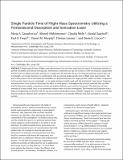Single-Particle Time-of-Flight Mass Spectrometry Utilizing a Femtosecond Desorption and Ionization Laser
Author(s)
Abdelmonem, Ahmed; Mohr, Claudia; Saathoff, Harald; Froyd, Karl D.; Murphy, Daniel M.; Zawadowicz, Maria Anna; Leisner, Thomas Konrad; Cziczo, Daniel James; ... Show more Show less
DownloadCziczo_Single particle.pdf (1.281Mb)
PUBLISHER_POLICY
Publisher Policy
Article is made available in accordance with the publisher's policy and may be subject to US copyright law. Please refer to the publisher's site for terms of use.
Terms of use
Metadata
Show full item recordAbstract
Single-particle time-of-flight mass spectrometry has now been used since the 1990s to determine particle-to-particle variability and internal mixing state. Instruments commonly use 193 nm excimer or 266 nm frequency-quadrupled Nd:YAG lasers to ablate and ionize particles in a single step. We describe the use of a femtosecond laser system (800 nm wavelength, 100 fs pulse duration) in combination with an existing single-particle time-of-flight mass spectrometer. The goal of this project was to determine the suitability of a femtosecond laser for single-particle studies via direct comparison to the excimer laser (193 nm wavelength, ∼10 ns pulse duration) usually used with the instrument. Laser power, frequency, and polarization were varied to determine the effect on mass spectra. Atmospherically relevant materials that are often used in laboratory studies, ammonium nitrate and sodium chloride, were used for the aerosol. Detection of trace amounts of a heavy metal, lead, in an ammonium nitrate matrix was also investigated. The femtosecond ionization had a large air background not present with the 193 nm excimer and produced more multiply charged ions. Overall, we find that femtosecond laser ablation and ionization of aerosol particles is not radically different than that provided by a 193 nm excimer.
Date issued
2015-11Department
Massachusetts Institute of Technology. Department of Civil and Environmental Engineering; Massachusetts Institute of Technology. Department of Earth, Atmospheric, and Planetary Sciences; Massachusetts Institute of Technology. Department of Electrical Engineering and Computer ScienceJournal
Analytical Chemistry
Publisher
American Chemical Society (ACS)
Citation
Zawadowicz, Maria A., Ahmed Abdelmonem, Claudia Mohr, Harald Saathoff, Karl D. Froyd, Daniel M. Murphy, Thomas Leisner, and Daniel J. Cziczo. “Single-Particle Time-of-Flight Mass Spectrometry Utilizing a Femtosecond Desorption and Ionization Laser.” Analytical Chemistry 87, no. 24 (December 15, 2015): 12221–12229.
Version: Author's final manuscript
ISSN
0003-2700
1520-6882